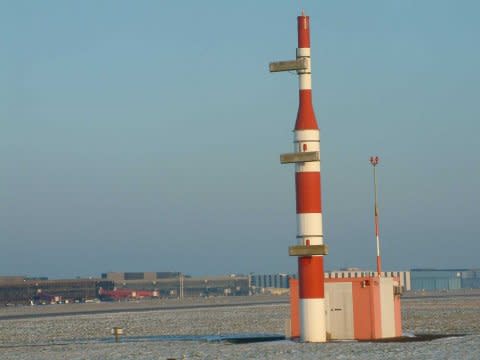A System Designed To Make Landings Safer Was Out Of Service When Asiana Flight 214 Crashed

A glide-slope station in Hamburg, Germany.
The pilots flying the Boeing 777 that crashed in San Francisco Saturday morning did not have access to a system designed to help them safely land the plane, National Transportation Safety Board (NTSB) investigators say.
The glide-slope, which provides vertical guidance to keep the plane at the right elevation and angle during its approach, was out of service to allow for construction to extend the runway safety area.
The ground-based system emits signals that are used to generate the glidepath, the route the plane should follow to the ground, according to the FAA.
"A glide-slope can give you a constant approach to the airport," NTSB Chairman Debbie Hersman said in a press conference Sunday.
The localizer, a similar system that provides horizontal guidance to lead the plane to the middle of the runway, was working properly when Flight 214 crash landed, killing two passengers and injuring scores of others.
"Pilots have available to them a number of options for how to get the plane in at the right speed, on the right approach on the right path," Hersman said Sunday. The glide-slope is just one of those tools. The NTSB chief added that the precision approach path indicator (PAPI), a light array next to the runway that also provides vertical guidance, was working properly.
In addition, the weather was fine, and planes have been landing safely on runway 28L since June 1, when the system was taken offline. It is scheduled to be back in working order on August 22.
"There should have been no problem whatsoever," retired United Airlines pilot Fluge Schoendienst told the Mercury News.
Patrick Smith, airline pilot, blogger, and author of Cockpit Confidential, agreed. "Pilots fly visual approaches into busy airports all the time," he said in an interview.
"Not having that particular instrument guidance, and being in an environment like San Francisco, that is high workload and can be challenging, those things may on some level have been a factor. But they do not explain landing short of a runway.” He added, "This stuff is routine."
While Hersman said Sunday that "everything is still on the table right now," there is no evidence that a mechanical failure caused the crash. Asiana Airlines said that Lee Kang-kook, who was in charge of landing the plane, was in training and had just 43 hours of experience flying the 777 jet.
A last second attempt to abort the landing failed, data recovered from the plane's black boxes show.
More From Business Insider

